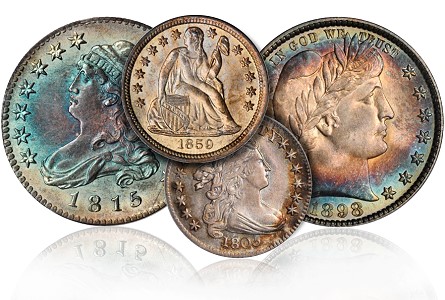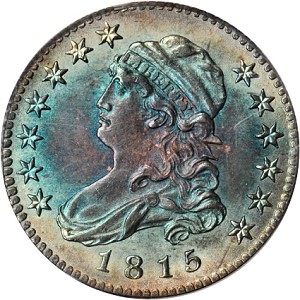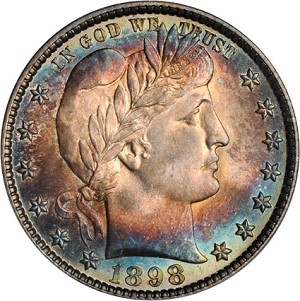News and Analysis on scarce coins, markets, and the coin collecting community #66
Special Edition – by Greg Reynolds
On Wednesday, in part 1, I provided an overview of the offerings in the upcoming Stack’s-Bowers ‘Rarities Night’ event. The Spectrum-Stack’s-Bowers firm will conduct their inaugural ‘Rarities Night’ on Thursday, Aug. 18, at the ANA Convention. Here in part 2, I discuss dimes, quarters, and more half dollars. I already mentioned a few halves in part 1, and I then discussed the scope of this ‘Rarities Night’ event. (Clickable links are in blue.)
I. Half Dollars
A coin that really stands out is the Queller 1803 Draped Bust, Heraldic Eagle Half Dollar. In October 2002, Stack’s auctioned David Queller’s collection of half dollars.
 The Queller 1803 is PCGS graded MS-63 and has a CAC sticker. There are not many contact marks and the natural toning is very pleasing. A silvery gray sheen is nicely balanced by blue-gray tones on the obverse; the reverse has more colors, including shades of russet and apricot. This coin looks better in actuality than it appears in images.
The Queller 1803 is PCGS graded MS-63 and has a CAC sticker. There are not many contact marks and the natural toning is very pleasing. A silvery gray sheen is nicely balanced by blue-gray tones on the obverse; the reverse has more colors, including shades of russet and apricot. This coin looks better in actuality than it appears in images.
It is common for pre-1840 U.S. coins, especially those dating before 1808, to be characterized by very noticeable U.S. Mint caused imperfections. This 1803 does not have any particularly noticeable imperfections. Moreover, this 1803 seems to never have been substantively cleaned and there is no apparent evidence of it ever having been dipped.
I really like the “1811/10” Capped Bust Half Dollar in this sale. Although the claimed overdate is not so clear, it is clearly of the “punctuated date” variety. It almost looks like there is a period between 18 and 11. This coin is PCGS graded MS-64 and has a CAC sticker. When this same coin was offered at auction in 2009, the cataloguer then noted that it was one of three that the PCGS has graded MS-64. Now, the current cataloguer notes that it is one of five. I would not be surprised if someone tried to ‘upgrade’ this specific coin. In my tentative view, the grade of this coin is in the ‘high end’ of the 64 range or the low end of the 65 range. The natural toning is stable, not dark and very appealing. Moreover, this half dollar has few technical imperfections. It is an exceptional coin.
As for the 1842-O Liberty Seated Half Dollar, of the “Medium Date, Medium Letters” variety, the PCGS holder indicates that it is from the “Eliasberg” collection. The cataloguer states that “the piece offered here does not match the illustration of the specimen in Bowers and Merena’s Eliasberg sale of April 1997.” Furthermore, it is just too white to be representative of the half dollars in the Eliasberg collection. IF it was part of the Eliasberg 1997 auction, it was dipped since that event.
Yes, this 1842-O half it is fairly graded MS-64 by the PCGS and it has a CAC sticker. I am not doubting the assigned grade or the integrity of the coin. Like the cataloguer, I wonder if it was ever really in the Eliasberg collection. It is, though, a desirable coin. This 1842-O has naturally retoned to an extant, with some russet areas. This coin’s grade is in the high end of the 64 range. For a discussion of the Eliasberg pedigree, please click to see my recent column on Eliasberg coins traveling to Chicago.
The Osburn 1865-S half is also said to be from the Eliasberg collection. Indeed, it is so indicated on its NGC holder, and it may have been. It does not, though, have one of the ‘Eliasberg looks’ that I recommend collectors learn about. It could have resided in the Eliasberg sale without toning very much, or it could have been dipped in the late 1990s, or early 2000s, and then naturally retoned in the decade or so that followed. In any event, the Osburn 1865-S is a nice coin. I do not have an objection to the coin itself or to the NGC grade of MS-64. I just hope that many more collectors will have opportunities to acquire Eliasberg silver coins that feature attractive, stable, medium to deep toning that naturally developed over a period of several decades or longer.
As I pointed out last week, Dick Osburn’s epic set of Liberty Seated Half Dollars will ‘leadoff’ the Rarities Night event. The Osburn 1870-CC half is terrific looking and is one of the most important coins in his set. While the NGC’s assigned grade of MS-62 is debatable, it does not bother me. I wish the best of luck to anyone who figures that he or she can find a significantly higher quality 1870-CC half.
The 1870-CC half is rare in all grades, perhaps very rare, and this specific coin is quite a condition rarity. The NGC has graded one as AU-58, the “Joseph Thomas” 1870-CC, and this one as MS-62. No other 1870-CC halves are NGC graded AU-58 or higher. The PCGS has graded two as AU-58, one as MS-62, and no others higher than 55.
The Osburn 1870-CC was formerly in the Reed Hawn and James Pryor collections, both of which are very famous collections of half dollars that will be cited for generations to come. The Osburn 1870-CC coin has wonderful natural toning. The russet, tan, brown and blue shades blend nicely on the obverse (front), with some green in the outer fields. The toning on the reverse is even more balanced, if I remember correctly, with orange-tan-beige devices, tannish-gray inner fields, and blue outer fields.
It is hard to imagine an 1870-CC half in the AU-55 to MS-62 range that is more attractive than the Osburn 1870-CC. I am not aware of any 1870-CC halves that grade above MS-62.
Though not in the same league, in terms of rarity, as an 1870-CC, I am impressed by the Osburn 1877-S, which is NGC graded MS-65. This half dollar has really nice natural toning and is very attractive overall. There is no reserve on this coin. For the just mentioned 1870-CC, there is a minimum bid of $115,000.
The Osburn Philadelphia Mint 1878 also caught my attention. While I prefer toning that is decades old, this coin has been moderately dipped and then the devices naturally retoned, sort of light brownish-russet shades. There is still some dip-blue color in the fields, which some people like. I believe I remember a subtle, neat pale-green overtone. This 1878 is NGC graded “MS-64+,” which seems fair enough. Note that I wrote about the Osburn 1878-S in part 1.
II. Capped Bust Quarters
 There is a very newsworthy run of Capped Bust Quarters in this ‘Rarities Night’ event. Richard Jewell’s 1815 has bright, colorful toning, about which I am not completely comfortable. It is PCGS graded “MS-65” and has a CAC sticker. There is no reserve and the bidding went over $40,000 by the evening of Aug. 10th ($36,001+15%). Bidding has thus already entered the price range for a MS-66 grade 1815 quarter and the final price could be much higher.
There is a very newsworthy run of Capped Bust Quarters in this ‘Rarities Night’ event. Richard Jewell’s 1815 has bright, colorful toning, about which I am not completely comfortable. It is PCGS graded “MS-65” and has a CAC sticker. There is no reserve and the bidding went over $40,000 by the evening of Aug. 10th ($36,001+15%). Bidding has thus already entered the price range for a MS-66 grade 1815 quarter and the final price could be much higher.
One my favorite 1815 quarters, which I like more than this Jewell 1815, went for $37,375 in the Jan. 2010 FUN auction. (Please click to read about it.) It is PCGS graded MS-66. Subsequently, Steve Tompkins, a noted researcher, declared that the one I raved about was previously NGC graded MS-68, before it was NGC graded MS-67. So, its certified grade went from 68 to 67 to 66.
I am very attracted to the 1818/5 overdate quarter to be offered during ‘Rarities Night.’ The pleasant, mellow toning is soothing. It does not exhibit any sign of having been dipped or ever substantively cleaned. There are not many contact marks.
This 1818/5 quarter is NGC graded MS-65. Of course, I realize that is not fully detailed. These, though, are usually lacking detail. Through some research, I found images of another NGC graded MS-65 1818/5 that has much less design detail than this one. Indeed, many 1818/5 quarters that are certified as grading from MS-64 to -66 have weak details. When the neat colors on this coin are seen in actuality, the fact that this coin is not fully detailed tends to be overlooked. Though I just glanced at it quickly, my tentative impression is that this is an excellent coin.
The Norweb Proof 1820 Capped Bust Quarter will be discussed at another time. There is just not space here for discussions of early Proofs.
The next lot, an 1822 quarter, was also previously in the epic Norweb Collection. B&M (New Hampshire) auctioned the Norweb family’s collection of U.S. coins in 1987 and 1988. Indisputably, the Norweb family had one of the ten all-time greatest collections of U.S. coins. The Norwebs also collected colonial coins, medals, world coins and other numismatic items.
This Norweb 1822 quarter to be offered is PCGS graded ‘MS-61′ and is of the over-denomination variety. On the reverse die, ’25 C’ for twenty five cents was punched over the numerals ’50’ for fifty cents, which were earlier mistakenly punched. Collectors frequently acquire this variety ‘as if’ it is a distinct, separate ‘date.’ It is listed as a “major variety” in the PCGS registry and is a required ‘date’ in the NGC registry for a complete set of the first type of Capped Bust Quarters.
The Norweb 1822 25/50, presumably this coin, is said, in the PCGS registry, to have an “estimated grade” of “MS-60.” Evidently, it was estimated by the PCGS to grade MS-60 before it was actually PCGS graded “MS-61.” Such a determination of 60 or 61 depends upon how the severity of the scratches and light gashes are evaluated. If these are thought to be easily overwhelmed by the natural toning and overall aesthetic appeal of the coin, then it could grade MS-61. If these are deemed to be serious problems, then this coin would be fortunate to grade MS-60.
While the scratches and gashes are substantial, this coin has some of the characteristics of a MS-62 or higher grade coin. The nearly uniform, medium brownish-russet-tan toning is soothing. Indeed, it has ‘the look’ at a glance of a much higher grade coin. In my view, it definitely merits a numerical grade. An overall rating of 61 is fair enough.
If an enthusiast for bust quarter varieties obtains this coin, he or she is likely to be happy with it. There are only around forty 1822 25/50 overdenomination quarters in existence and it is very difficult to find one that grades even AU-55.
Bust quarter enthusiasts likewise will compete for the next lot, an 1823/2 quarter, which is extremely rare in all grades. Perhaps fifty exist. There are no 1823 ‘normal date’ quarters. All ‘1823’ quarters are 1823/2 overdate quarters.
This 1823/2 is PCGS graded “Good-06.” While not a spectacular coin, it is especially appealing for a “06” grade early U.S. coin. Several other 1823/2 quarters that grade from Good-04 to VG-10 are less attractive than this one. As of the morning of Aug. 11, the reserve had been met and the current level for this coin was nearly $38,000.
Curiously, I just noticed that the PCGS registry lists the Norweb 1823/2 as being PCGS graded “AU-58.” It was “pedigreed” by PCGS experts on “05/27/08.” Certainly, that is one of the finest known 1823/2 quarters.
While not in the same category as the 1823/2, the 1825/2 overdate is very rare to extremely rare. It is sometimes referred to as the “1825/4/2.” Unlike the case with the 1823/2, there exists more than one date, really overdate, of ‘1825’ quarters; these are easily differentiated by the spacing of the numerals of the year, one variety has widely spaced numerals and the other has more closely spaced numerals. Nonetheless, the offering of a high grade 1825/2 (or 1825/4/2) is important. The one in this sale is NGC graded “AU-58” and has a CAC sticker of approval.
While deeply toned, it is not too dark. This is a very impressive coin. The toning, mostly brownish russet, is definitely natural and appears to be very stable. I note a few hairlines, though these are hardly noticeable. Furthermore, this quarter has minimal contact marks. While there is some very light friction on the highpoints, a 61 grade for this 1825/2 would be well within the realm of reason. I believe that this is the finest of this ‘date’ that I have ever seen.
This same 1825/2 quarter sold for $18,400 on Sept. 21, 2006 in an ANR auction. This time, the reserve puts the first allowed bid at $12,650, which is reasonable.
In this auction, there is an 1831 quarter that is NGC certified “MS-65*.” I have not yet drawn a firm conclusion about it. I am skipping over the Liberty Seated Quarters, although the ones being offered are significant, because these particular Liberty Seated Quarters require a good deal of explanation, which cannot practically be provided here.
III. Barber Quarters
In the ‘Rarities Night’ event, there are just two Barber Quarters and these are both great coins. Both are PCGS graded MS-66 and have a sticker from the CAC. Additionally, both of them were struck in New Orleans.
 I have seen the Duckor 1898-O before. It was in the Silbermunzen collection that Heritage auctioned in May 2008 at Long Beach. On July 31, 2009, Heritage auctioned Dr. Duckor’s collection of Barber Quarters in Los Angeles as part of a pre-ANA ‘Platinum Night’ event. Now, this 1898-O is part of “the Chicago Collection,” according to the cataloguer.
I have seen the Duckor 1898-O before. It was in the Silbermunzen collection that Heritage auctioned in May 2008 at Long Beach. On July 31, 2009, Heritage auctioned Dr. Duckor’s collection of Barber Quarters in Los Angeles as part of a pre-ANA ‘Platinum Night’ event. Now, this 1898-O is part of “the Chicago Collection,” according to the cataloguer.
The Duckor 1898-O is has terrific natural toning and ‘the look of a 67+ grade’ quarter. More than two short scratches on Miss Liberty’s face keep it from grading 67. Perhaps it grades 66.6.
From the same consignor, a 1909-O quarter likewise has ‘the look’ of a 67+ or even of a 68, yet is graded 66 because of scratches on the face. Its natural toning is just wonderful. The exceptionally pleasing blue center on the obverse is complemented by russet and apricot peripheral toning. The reverse is even better. A richly glowing orange center is evenly surrounded by shades of russet, apricot-russet, blue, greenish-blue, and other colors. I am very fond of both of these quarters.
IV. Dimes
There is an exceptional selection of dimes in this auction. The NGC graded MS-65 1796 is likable. There are some U.S. Mint caused imperfections in this coin and these do not bother me very much. Further, there are very few contact marks. This coin does not have any significant issues.
This is the first year that dimes were minted. (The Norweb 1792 pattern dime, struck in copper, is in this same auction.) The Draped Bust, Small Eagle type was produced for only two years, 1796 and 1797. The second Draped Bust type was minted from 1798 to 1807.
There are a few Draped Bust, Heraldic Eagle dimes in this sale, including two 1798s, each with a ‘Large 8.’ The first of these, I would not recommend. The second was formerly in the Eliasberg collection and is appealing. It is now PCGS graded “MS-63.” Some luster shines about natural brownish-russet toning.
During ‘Rarities Night,’ two 1800 dimes will be offered. I am enthusiastic about the first one, which is PCGS graded “MS-63” and is CAC approved. The blue and gray natural toning complements shiny silvery areas. This 1800 dime has minimal contact marks and hairlines. Indeed, these are barely discernible with a magnifying glass. This coin is certainly ‘high end’ and is more than attractive.
Though 1805 is not a rare date in the Draped Bust, Heraldic Eagle series of dimes, the one in this sale is a terrific type coin. It is PCGS graded MS-66 and has a CAC sticker. The grade of this coin is in the middle to ‘high’ end of the 66 range, in my view. A subtly glowing bust of Miss Liberty is made even more appealing by natural light russet and light blue overtones. The orange-russet obverse outer devices add to this coin’s charm. The reverse is not as appealing as the obverse, though it is very attractive.
As of the early evening of Aug. 11, bidding for this coin has already reached $46,000, and the reserve has been met. My guess is that the final price will be higher.
Some of the Proof Capped Bust and Liberty Seated Dimes in this sale are extremely important and should really be handled in a separate discussion. There is just not space here to shed light upon them. Besides, far more people collect business strike 19th century dimes than Proofs.
The ‘Rarities Night’ event contains a few Proof Capped Bust Dimes and only one business strike, which should be mentioned. It is a PCGS graded “MS-67” 1834 dime. Certified MS-67 and -68 grade Capped Bust Dimes are certainly condition rarities and are strongly demanded by collectors assembling type sets.
The experts at CAC are accepting of this coin’s “MS-67” grade. Further, Mark Feld was a full-time NGC grader from 1991 to 1998 and he says that this is “a great looking coin, worthy of the grade.” I am not so sure. The toning on the reverse is clearly natural. The green-blue toning on the obverse is very bright and has an unusual ‘look.’ IF the obverse toning is natural, then the grade of this coin is certainly a mid range 67.
San Francisco Mint Liberty Seated Dimes from the 1850s are rare dates and are leading condition rarities in high grades. There are important representatives of all three in this auction, an 1856-S, an 1858-S and an 1859-S. The U.S. Branch Mint in San Francisco did not get started until 1854, and no 1854-S, 1855-S or 1857-S dimes were minted.
The 1856-S dime is rare in all grades and this is likely to be one of the five or six finest. It is PCGS graded MS-63 and has a CAC sticker. It is grade is, in my view, in the high end of the 63 range.
The 1858-S in this sale is PCGS graded “MS-62” and is also CAC approved. It is very attractive for a certified MS-62 Liberty Seated coin. This could certainly be among the five finest known 1858-S dimes. Overall, 1858-S dimes are probably even rarer than 1856-S dimes.
The 1859-S dime is one of the most important coins in this auction. It is rare in all grades and, as far as I know, this is clearly the finest known 1859-S dime. It is PCGS graded MS-65 and it is CAC approved. The NGC does report a 63, 64, or 65 grade 1859-S. The PCGS has graded one 1859-S dime as MS-63 and only this coin is graded higher than MS-63.
This 1859-S dime is a bright, attractive coin, with a number of miniscule contact marks that are consistent with a 65 grade. Personally, I prefer coins with a more original look, though this dime is nicely naturally retoning with mild brownish-russet areas and light blue centers. A large percentage of expert graders, particularly those who are influential in the coin business, would agree that this coin’s grade is at least in the middle of the MS-65 range.
This auction also features one of the finest known 1865-S dimes and highly certified representatives of two of the rare Carson City issues from the 1870s, 1871-CC and 1873-CC. I hope that I have time to write a separate article on all the important Carson City coins in this auction.
As for Mercury Dimes, there are just three in the ‘Rarities Night’ event. A 1919-S is PCGS certified ‘MS-65 Full Bands.’ Two 1942/1-D overdate dimes are each PCGS certified ‘MS-65 Full Bands’ and each has a CAC sticker.
The lone Roosevelt Dime is one of the most noteworthy coins in this auction. It is one of two Proof 1975 dimes that is lacking an ‘S’ mintmark. All Proof 1975 dimes were minted in San Francisco. Except for two, each of these has an ‘S’ mintmark. The absence of a mintmark on a Proof 1875 dime indicates that an error was made. It was intended for all Proof 1975 dimes to have ‘S’ mintmarks. Such errors, particular of dimes and cents, occurred in other years during the 1960s and 1970s. This seems to be the rarest ‘No S’ Proof dime and a Proof ‘No S’ 1975 Dime has never before been offered at auction. This 1975 dime is PCGS certified ‘Proof-68.’ I am curious as to how much it will realize at auction.
Next week, I will write about gold coins that will be offered in the ‘Rarities Night’ event. I mentioned a few of them already in Wednesday’s column, which provides an overview of the first Stack’s-Bowers ‘Rarities Night.’
©2011 Greg Reynolds





This is a great overview of these coins. Thanks again Greg